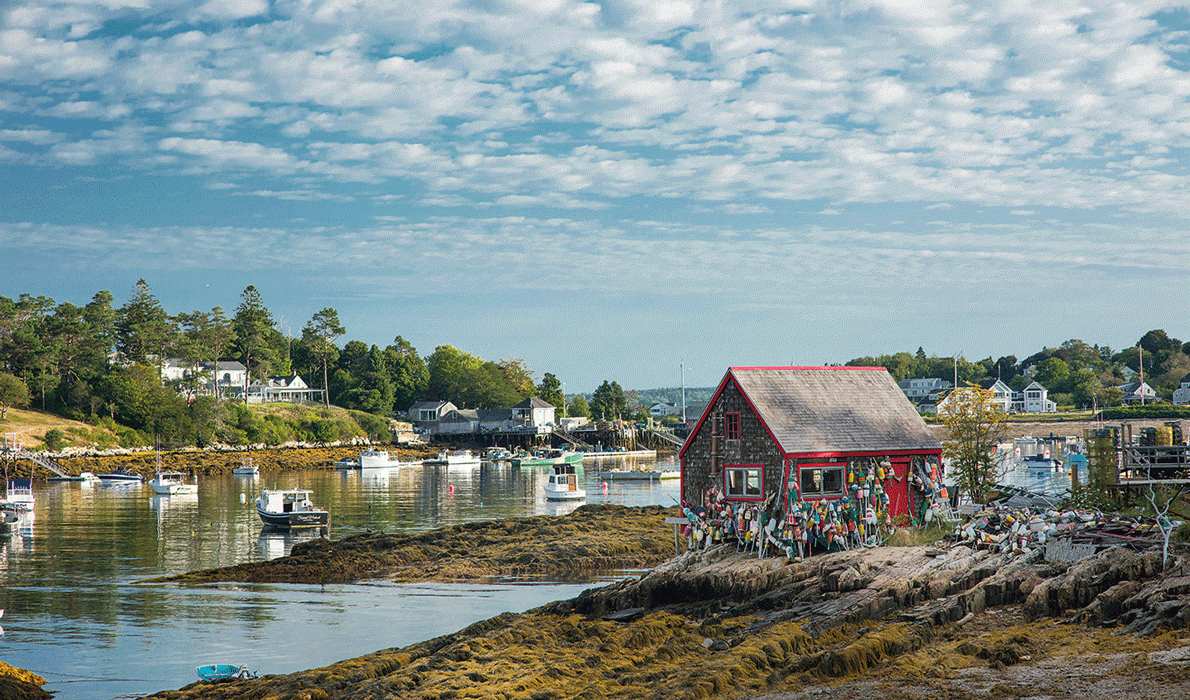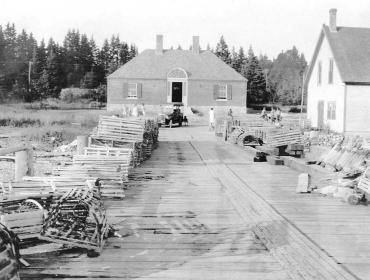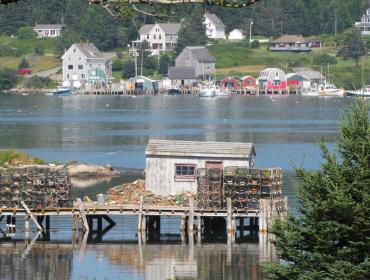Posted July 18, 2018
Last modified July 18, 2018
… So that’s
how it is out there in Maine. Be careful out there
– Patricia Ranzoni, “Cultural Guide”
The southwest tip of Bailey Island is called Land’s End, for good reason. Just off the gift shop parking lot, the other side of Jaquish Island, is the open ocean. Stiff, bleak, salt-scented breezes from thousands of miles away scour the ledges and roil up white foam.
It’s the easternmost extent of Harpswell you can drive a car. To get there you travel Route 24 across Great, aka Sebascodegan, Island and Orr’s Island, then cross to Bailey Island on the cribstone bridge built in the 1920s, much to the contentions of the islanders. It is legendarily one of only two of its kind, a webwork of granite slabs to accommodate the tides in Will’s Gut. The other cribstone bridge is reputedly in Scotland. Or Ireland, as my father confidently misinformed me when I was a kid.
We spent a lot of time on Bailey Island, but rarely drove there. Every summer day in the early 1960s we flew in my father’s three-seater seaplane from Great Pond in Cape Elizabeth, where we lived, to Mackerel Cove. The flight skirted east of Ram Island light and over Cliff and Jewell islands, forming an aerial map in my brain. On Haskell Island, a lone farmhouse was mysterious to a 10-year-old in the sky. What was it like down there? Finally we landed in the long cove and taxied among moored boats to Merrill’s Wharf, where my father gave 15-minute rides to tourists for $3 a person.
I remember in that mythic past running a 14-foot flat-bottomed punt between the wharf and a float where the seaplane docked. My job was to catch the plane as it glided up to the float, reassure nervous passengers, and keep the pontoons pumped out.
In between hops of the plane, I lived long dreamlike afternoons on the kelp-smelling wharf, watched seagulls and lobster boats, studied the shale-flat water. It was said that if you could swim a straight shot across the cove from Merrill’s Wharf to Steamboat Wharf, you were deemed a good swimmer. I wished I could swim better.
Some afternoons, often during the tuna tournament in late July, a stiff southwest wind would run up the cove. The water would go cobalt blue, whitecaps tore in, and licks of spray corrugated everything. Soon 400- and 500-pound bluefin tuna were being hoisted by the tail on pulleys at the end of the wharf, true monsters from the deep. The tournament started in 1938 and now operates from Cook’s, at the bridge end of the island. My father tried running the seaplane from Cook’s dock, if I remember right, but it was an even dicier place to be landing and taking off a seaplane, partly because of the tide quick-kicking through the perilous gut.
Anyway, tourists landed at Merrill’s twice a day on the Casco Bay Lines ferry. I helped the deckhands by catching the heavy lines they threw as the diesel engine roared and the boat slipped to dock.
At Merrill’s there was a lobster pound, lunch counter (hamburgers, 35 cents), and floats where summer sailors picked up gas and supplies. One of the college kids who worked the floats was famous college baseball player Stump Merrill. I remember him, rag in hip pocket, bemused by my and my sister’s antics. On a sunny June afternoon in 1964, he and I listened on the radio to Jim Bunning finish pitching his perfect game. At least, that’s my recollection. I’m sure Stump’s long forgotten. Later he played for the Phillies and managed the Yankees.
I gathered periwinkles. Pulled up seaweed to disturb crabs. Smashed a Coke bottle or two. We fished with handlines for lazy pollock off the floats, practicing catch, kill, and release. One summer a fishing-family kid and I put out a lobster trap halfway up the cove and tended it in the punt. We caught no lobsters, but pounds of rock crabs, which I brought home in pails. My mother and I spent hours picking them for sandwiches.
Sometimes softball games got organized on the sloping field between the head of the cove and the road to Land’s End. Nearby was the island library where—unbeknownst to a parochial Maine kid—people I never met had hosted Carl Jung for a lecture series less than 30 summers before. I got in trouble for wandering off to the games by the road.
I never explored on Abner’s Point Road along the western shore of Mackerel Cove. In my childhood myth, it is a forbidden land. Something about the people who lived there not wanting me around. Was it really off-limits, or is that a figment of my east-of-Eden boyhood? It seems like even the fishing-family kids, whose blood has been genetically modified to produce oppositional defiant disorder, avoided that hilly road. What were the houses like out there.
Whether I was summer people or island people was never clear to me. We didn’t live on the island and didn’t fish for a living; to some islanders, we were flatlanders, from away. On the other hand, we were part of the tourist industry. And my mother’s ancestors had arrived in Boothbay in the 1700s, part of this same fishing-family ilk. So I was subject to certain prohibitions, like my friends. It’s one of the largely unexplored regions of the native psyche. I did not come out of Maine’s tourist summers unscathed.
One calm day in between seaplane hops I drove the punt to the mouth of the cove, where you at last see only sea. The water was flat and metal dark in the cove. Out clear of Abner’s Point, the surface was still polished, but there were swells. Up went the barely seaworthy flat-bottomed punt, then down. Up too high, then down, too low. My gunnels seemed as flimsy as cardboard. Was it less dangerous to pitch or roll? I turned the bow back out of the rolling enormous ocean and back to the cove. It was the first time the ocean terrified me.
Summer evenings the seaplane would curl up out of Mackerel Cove to head home, sometimes looping east over the Giant’s Stairs shore and then Ragged Island. I studied the windswept house, below, where Edna St. Vincent Millay had spent summers. I had heard of her even then. What was that life like.
Dana Wilde lives in Troy. His recent book is Summer to Fall: Notes and Numina from the Maine Woods; www.northcountrypress.com/summer-to-fall. His email address is naturalist1@dwildepress.net.

MICHELE STAPLETON
Harpswell scenic view
Contributed by




